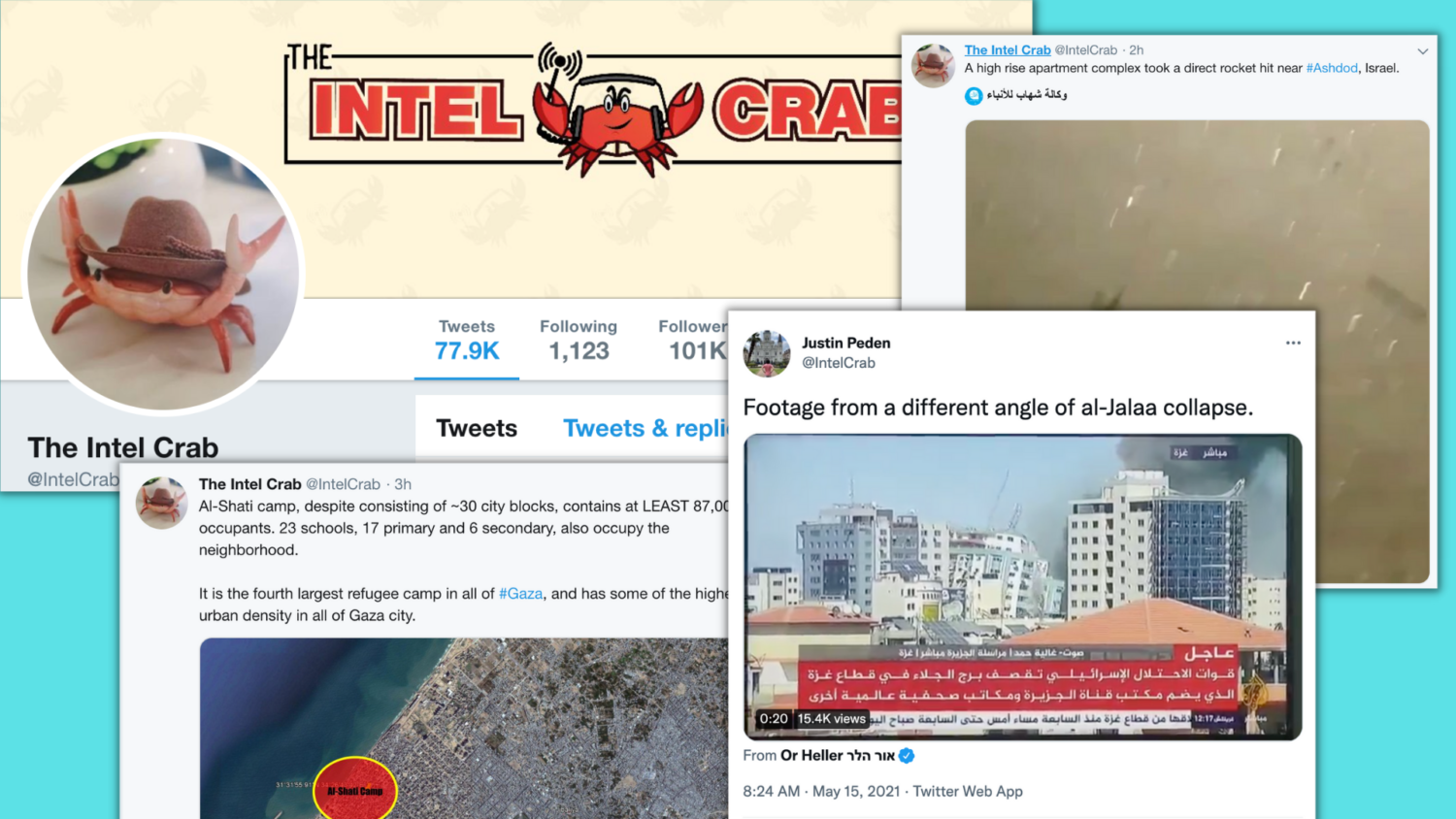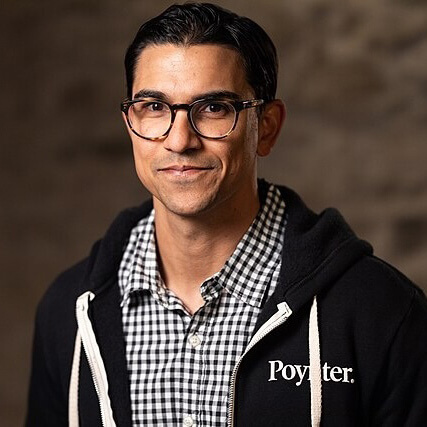I first stumbled across The Intel Crab in 2021.
The anonymous Twitter account shared videos showing an Israeli airstrike hitting Associated Press offices in the Gaza Strip. The footage that grabbed my attention was legitimate and unique. I quickly added the profile to a list of open-source intelligence — known as OSINT — accounts I follow when big news breaks.
OSINT analysts include professional journalists at major newspapers and digital investigative reporters. They have investigated the killing of Al Jazeera journalist Shireen Abu Akleh and exposed alleged war crimes in Ukraine.
But some of the most-followed accounts include think tank academics and anonymous amateurs who are adept at tapping Google Earth and other digital tools to verify war footage.
Until earlier this year, The Intel Crab, which has more than 250,000 followers and a reach in the tens of millions, was among the latter. But Justin Peden, a 20-year-old sophomore at the University of Alabama-Birmingham who only recently switched his major to journalism, revealed his identity earlier this year.
“I’m no longer anonymous for one simple reason: I want to be held accountable for my work,” Peden told me. “Both positively and negatively.”
Working with college students through the MediaWise Campus Correspondents program, and with a personal interest in OSINT and geolocation, I felt compelled to reach out. In an email interview, Peden laid out his process for verification, discussed the ethics of amateur investigative reporting and what the open-source intelligence community says about the state of the journalism industry.
(This interview has been lightly edited for length and clarity.)
Let’s start with the most important question: Why the name Intel Crab?
I … don’t know. Truthfully. I started the account under a fake Russian name in an attempt to follow and interact with people living in Donbas. It was rather silly in hindsight, but about a year in, I realized that I was sitting on this incredibly valuable stack of thousands of people — some even my age — who lived in an area that had a lot of outside attention. In a sense, I became a sort of aggregator of war reports from the region. It was around this time I thought up the Intel Crab name and, well, the rest is history. I guess crabs are known for digging around? Maybe that’s what 15- or 16-year-old Justin was thinking at the time. Who knows, but the name sure stuck.
So … take me back, do you remember the first video or image you found online that sparked your curiosity? One that you immediately wanted to investigate?
Despite my age, I’ve been doing this for a long time. At least six years. Before I started working with commercial satellite data or other fancy stuff like that, a lot of my fascination was funneled into countless hours on Google Earth. I remember being particularly fascinated with the ruins of the Donetsk International Airport: This massive, sprawling complex that was totally destroyed in the war in Donbas. I would zoom into the airport and use the “back in time” feature to look at satellite images of the complex from before the conflict even started. To see such a dramatic change to the airport occur in such a short amount of time really captivated my imagination, and in many ways pushed me to Twitter, where I soon followed hundreds of local Donbas residents who called this warzone home.
What’s your process for finding and verifying — or debunking — videos?
Some of this process is outsourced. I’ve developed over the years a rather large community, whether they be nerds like me or professionals who do this kind of stuff for a living, that help me in verifying photos and videos that I might have doubts with. When it’s just me, I typically use open-source methods like reverse image searching and sometimes even file data to verify an image. Other times, I use mapping software and Google Maps Street View to geolocate a supposed image to a concrete location.
How often do you get videos directly from sources? And what’s the platform for that?
Not that often. The nature of the ongoing conflict in Ukraine makes direct peer-to-peer messaging a bit challenging, so when I am sent something directly from the area, it’s often either via Twitter direct messages or Telegram. I also use foreign social media sites like VK to find images and videos that others might not ever come across.
What are your favorite OSINT tools or techniques?
Toward the start of the war in February, I found myself using free, openly available mapping services like Google Earth and Yandex Maps and pairing them with paid commercial satellite data to geolocate Russian airstrikes, artillery strikes and other points of interest. This whole process, known as geolocation, is something I’ve gotten quite good at over the last few months. A simple image can provide so much insight into where exactly it was taken. All it takes is a cross-check with maps or commercial satellite data to confirm what might have otherwise been a simple hunch or theory.
A NOTE FROM POYNTER TEACHING
How to use open source intelligence in your classroom
Open-source intelligence, or OSINT, is reshaping the way security experts, journalists and fact-checkers verify information — and it has implications for your teaching. Join us at this year’s Teachapalooza as MediaWise’s Alex Mahadevan and open source intelligence expert (and University of Alabama-Birmingham junior) Justin Peden will walk you through the tools and techniques used by the OSINT community and explain how you can use them in your classroom.
This in-person and virtual conference takes place June 10-12, and spots are still available by registering here.
What’s your most memorable exchange with a source or other member of the OSINT community?
This one is slightly off prompt, but something to this day I find very cool. I did an interview earlier this year with “PBS Newshour” and got the amazing chance to speak with Miles O’Brien. Miles has done some amazing work over the years, but to my surprise, he essentially is responsible for the eventual success of Google Earth. His use of the early version of the software during CNN’s 2003 coverage of the Invasion of Iraq was crucial in its later success. Google Earth is such a cornerstone of my work, so it was incredibly cool to meet the man (arguably) responsible.
What are your thoughts on the ethics of OSINT? For example, do you follow any personal rules when you set about verifying, geolocating and posting a video?
This is an unfortunate downside to the community, and something more relevant than ever as the war continues: The hobby is decentralized. There are no publishing deadlines. No censorship. Zero accountability. It’s the Wild West, in many ways, and it really comes down to the individual.
I’m no longer anonymous for one simple reason. I want to be held accountable for my work: Both positively and negatively. Any slip-up I make is one I personally made, and in such a dynamic environment, these slip-ups can really have some profound effects. I’ve stopped geolocating content in areas held by Russian forces. It’s simply too much. I once rather infamously geolocated a video from occupied Kherson, only to delete it moments later. I realized that — without thinking first — I had outed the location of someone who was actively posting anti-Russian sentiment on her Twitter.
This was a defining moment for my Twitter activity, and I’ve since taken a step back from the wall-to-wall coverage and instead focused on projects with a more macro lens. In short, just because you can geolocate something, does not mean you should. This concept ties directly into the ethics of the community as a whole, and is sadly something not everyone understands. All you can do is set an example and hope others follow.
What should journalists know about reporting on the OSINT community?
I feel journalists have a hard time covering the community, because they often approach it expecting some sort of centralized, coherent organization to it. I can’t even count how many times I’ve been asked if there is some sort of website or wiki where we all congregate. While there are no doubt resources and forums out there for insight, the open-source nature of the hobby means many of us really do work alone. Especially those of us who do it for no other reason than curiosity or advocacy. The techniques of one person in the community are completely polar to someone else. While we may have overlapping interests, the means and tools of us getting to the answers are far from standardized. So too are their motives.
Literally as I was working on this Q&A, Twitter released guidelines for addressing misinformation about the war in Ukraine on the platform. What are your thoughts on the announcement?
I think it’s a great idea … at least on paper. Automating the rules laid out in the latest policy change is worrying, however, and I can imagine that a good bit of work in the OSINT realm may be struck down despite being purely analytical in nature. Sort of a wait-and-see situation, but it also seems like our best hope against some of the Russian disinformation we’ve seen shared and spread on the platform since the war’s start. Time will tell.
You see a flood of videos and images every day, what percentage would you say are misleading or straight-up false? How do you feel about the disinformation problem on social platforms?
Easily 50% of everything I see in my timeline is either sensationalized beyond comprehension or straight-up false. No other way to sugarcoat it. A growing amount of both my work and others is not just to make new discoveries, but debunk ongoing garbage before it gains traction. It’s a daunting task, but one that is needed as the war rages both physically and on social media.
I feel that social media — Twitter in particular — is simply not doing enough to fight this problem. So much of their algorithm favors quick bursts of engagement, allowing fake videos and images to spread everywhere far before anyone can correct it. And even by then, it’s often too late. From old footage to screenshots of video games, fabricated content regarding the War in Ukraine takes little talent to get shared thousands of times. And I think that alone says something.
What do you think the rise of OSINT says about the journalism industry?
A lot of the OSINT tricks both others and myself use on a weekly basis have existed for decades now in the investigative journalism profession. Accessing commercial satellite data. Geolocating footage. None of this is inherently new, but until recently, this information was collected simply to corroborate already existing claims or speculation.
Now, however, we have seen entire stories told from an office chair. These tools have grown immensely powerful, and as a result, the journalism industry is leaning heavily into them. Think of the immensely popular VOX, for example, a great inspiration for what I do. So much of their content revolves around stories all originating from a simple commercial satellite discovery or even images available via the national archives. They use editing software to make beautiful, illustrative map flyovers, an ability they’ve gotten so good at that they almost look like drone shots. It’s an incredible thing to see, and even more impressive when you realize that what they’ve uncovered is something anyone with a keyboard and internet connectivity could uncover, too.
Who do you look up to in the OSINT community? How about in the traditional journalism world?
As far as OSINT goes, Eliot Higgins is no doubt one of my favorites. His work with Bellingcat has revolutionized digital investigation, and is almost single-handedly responsible for giving the OSINT world — including myself — credibility. As far as those I look up to in the traditional journalism field, I’d have to say Simon Ostrovsky and his ingenious work with Vice News covering the Donbas insurgency back in 2014. He is one of the few people I can think of who covered that conflict in a way that was engaging and thought-provoking without also coming off as plastic or alarmist. His whole series with Vice is on YouTube, and I’d be lying if I said I do not to this day still watch it.
What’s your dream job?
No doubt an investigative journalist. So much of my excitement and interest on Twitter comes from a point of pure, blunt curiosity, and since I was 5 years old, I’ve wanted to somehow make a living exploring such curiosity. Being “the crab guy” on Twitter is great, but at the end of the day, I’m sitting behind a desk. I would love to get out there and interact with so many of the people I’ve admired for nearly six years now from behind a computer monitor. Safe to say a trip to Ukraine Is long overdue.
What advice do you have for college journalists who want to get into OSINT?
I should probably listen a bit more to my own advice. For the last two years, I’ve been a health care management major. None of that has ever interested me, but the thought of both doing what I love and getting paid for it seemed like a cruel dream at best. It’s only been after the last four months — months far crazier than I’ve maybe ever had before — that I realized it’s time to change majors. I’m now a communications major with a journalism focus, and while the concept of both having my cake and eating it too sounds crazy, I really think I’ve made a great decision that future Justin will hopefully be very happy with.
My advice, therefore, is to go for it. Realize that passion, no matter how hard you try to hide it or shift it into something unrelated, will always poke its way through to the surface. Take every second to use that passion to start exploring stories and problems that interest you now. Not later. The internet is your audience, and I’m a firm believer that good work yields good success.
OSINT is a very decentralized, messy net of websites, tools and techniques. It’s not something anyone can become an expert in overnight. But by using what is at your disposal, the possibilities and depth of what you can find are truly limitless.








